1. 스택 (stack)
데이터를 일시적으로 저장하기 위한 자료구조로, 가장 나중에 넣은 데이터를 가장 먼저 꺼낸다.
(후입선출 - Last In First Out)
스택 - 용어 및 메소드
- top - 스택의 가장 윗부분 (꼭대기)
- bottom - 스택의 가장 아랫부분 (바닥)
- push(item) - 데이터를 넣는 작업
- pop() - 데이터를 꺼내는 작업
- peek() - 스택의 가장 위에 있는 항목 조회
스택 - 예시
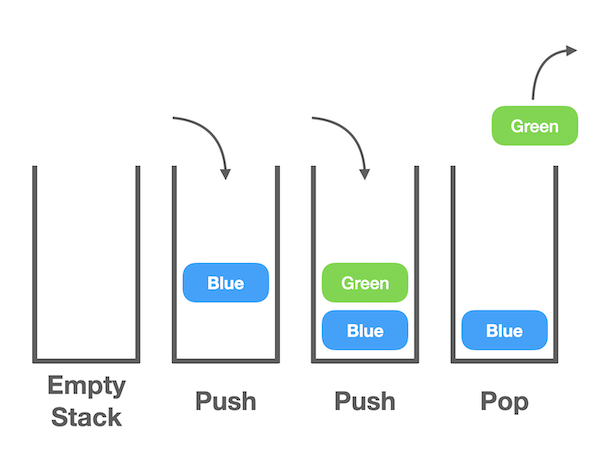
배열 스택
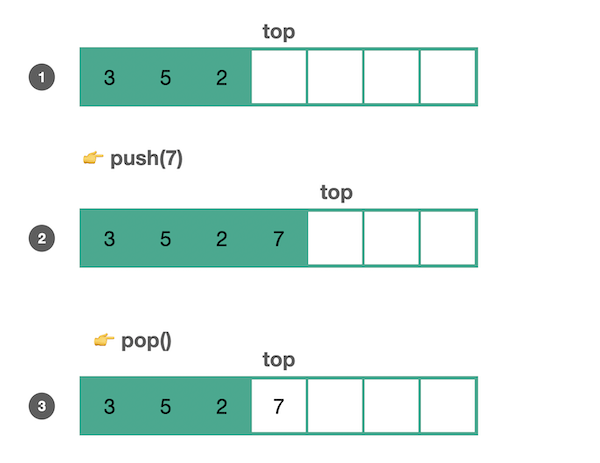
- push(7) → 배열의 top 자리에 7을 넣고, top을 한칸 뒤로 이동
- pop() → top을 한칸 앞으로 이동 후, 그 값을 리턴
연결리스트 스택
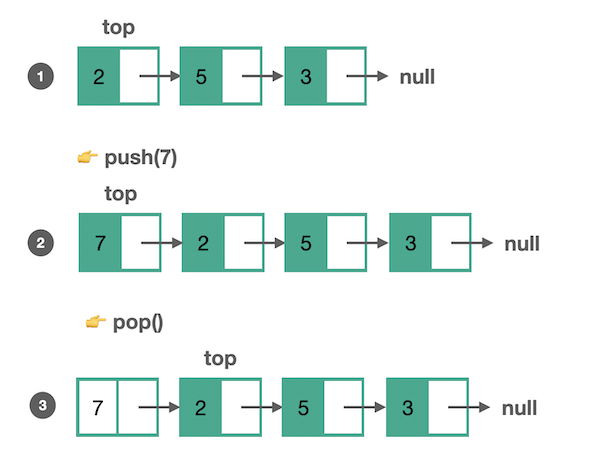
- push(7) → 노드[7]을 생성 후, 노드[7] next를 top(노드[2])으로 한다. top에 노드[7]를 대입한다.
- pop() → top(노드[7])에 있던 data를 가져온다. top을 top의 next(노드[2])로 변경한다.
앞의 data를 반환한다.
스택 구현 - Java 코드
int형 배열로 구현
public class IntArrayStack {
private int max; // 스택용량
private int top; // 스택 포인터 top (스택에 쌓여있는 데이터 수)
private int[] stk; // 스택 본체
public IntArrayStack(int capacity) {
top = 0;
max = capacity;
stk = new int[max];
}
/** 스택에 데이터를 push */
public void push(int x) {
if (isFull())
throw new OverflowStackException();
stk[top++] = x;
}
/** 스택의 꼭대기(top)에서 데이터를 pop */
public int pop() {
if (isEmpty())
throw new EmptyStackException();
return stk[--top];
}
/** 스택 꼭대기(top)에 있는 데이터 조회 */
public int peek() {
if (isEmpty())
throw new EmptyStackException();
return stk[top - 1];
}
/** 스택이 비어 있는지 여부 */
public boolean isEmpty() {
return top <= 0;
}
/** 스택이 가득 찼는지 여부 */
public boolean isFull() {
return top >= max;
}
}int형 연결리스트 구현
public class Node {
private int data;
private Node next;
public Node(int data) {
this.data = data;
this.next = null;
}
// getter, setter
}public class IntLinkedListStack {
private Node top;
private int size;
/** 스택에 데이터를 push */
public void push(int x) {
Node node = new Node(x);
node.setNext(top);
top = node;
size++;
}
/** 스택의 꼭대기(top)에서 데이터를 pop */
public int pop() {
if (isEmpty())
throw new EmptyStackException();
int result = top.getData();
top = top.getNext();
size--;
return result;
}
/** 스택 꼭대기(top)에 있는 데이터 조회 */
public int peek() {
if (isEmpty())
throw new EmptyStackException();
return top.getData();
}
/** 스택이 비어 있는지 여부 */
public boolean isEmpty() {
return size == 0;
}
}배열 → 검색 빈번, 등록/수정 적음
연결리스트 → 등록/수정 빈번, 검색 적음
스택의 사용 사례
- 재귀 알고리즘
- 재귀적으로 함수를 호출해야 하는 경우에 임시 데이터를 스택에 넣어준다.
- 재귀함수를 빠져 나와 퇴각 검색(backtrack)을 할 때 스택에 넣어 두었던 임시 데이터를 꺼낸다.
- 메소드 호출 스택
- 웹 브라우저 방문기록 (뒤로가기)
- 실행 취소(undo)
- 역순 문자열 만들기
- 후위 표기법 계산
- 수식의 괄호 검사
2. 큐 (queue)
데이터를 일시적으로 저장하기 위한 자료구조로, 가장 먼저 넣은 데이터를 가장 먼저 꺼낸다.
(선입선출 - First In First Out)
큐 - 용어 및 메소드
- front - 데이터를 꺼내는 쪽(맨 앞)
- rear - 데이터를 넣는 쪽(맨 뒤)
- enqueue(item) - 데이터를 넣는 작업
- dequeue() - 데이터를 꺼내는 작업
- peek() - 큐의 가장 앞에 있는 항목 조회
큐 - 예시
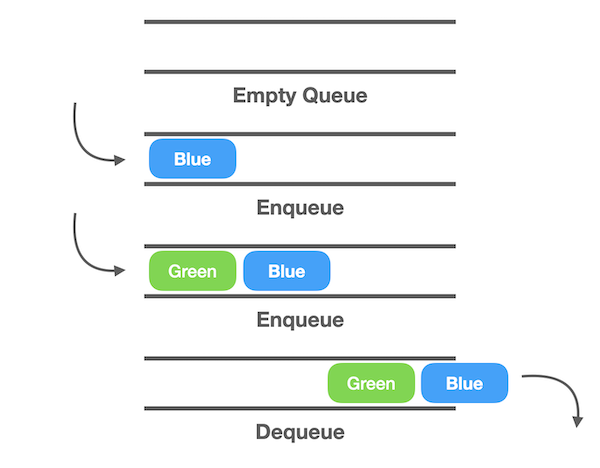
배열 큐
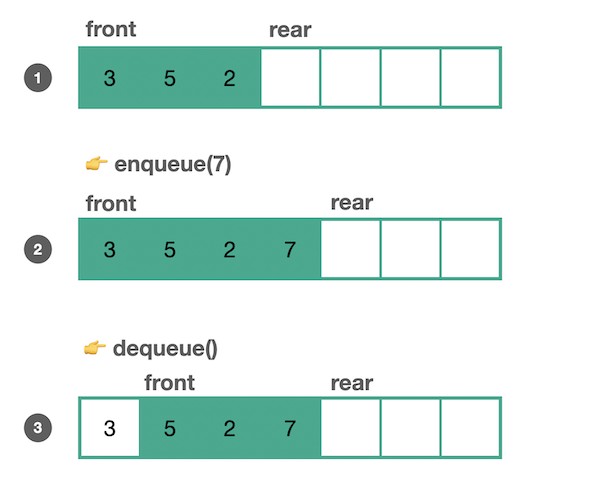
- enqueue(7) → 배열의 rear 자리에 7을 넣고, rear를 한칸 뒤로 이동
- dequeue() → 현재 front의 값을 반환 후, front를 한칸 뒤로 이동
- 문제점 해결 → 배열의 데이터를 전부 앞으로 옮겨주거나, 링 버퍼
배열 큐 - 링 버퍼, 원형 큐
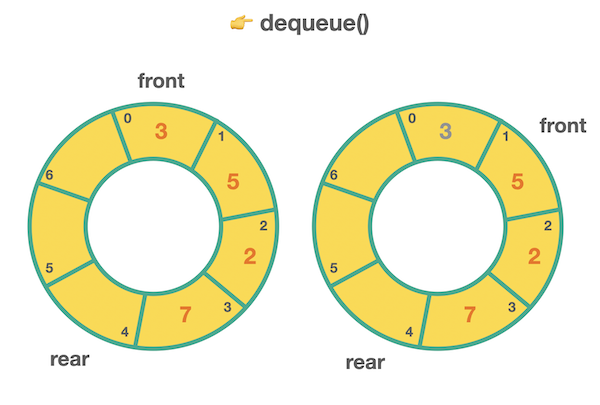
연결리스트 큐
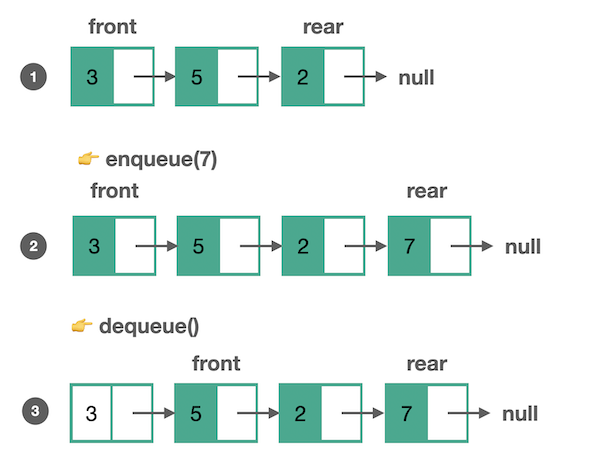
- enqueue(7) → 노드[7]을 생성 후, 현재 rear의 next값을 노드[7]로 변경. 그 다음 rear를 노드[7]로 변경
- dequeue() → front 의 노드[3] data를 저장 후, front를 front.next(노드[5])로 변경. data를 반환
큐 구현 - Java 코드
int형 배열로 구현
public class IntArrayQueue {
private int max; // 큐의 용량
private int front; // 첫 번째 요소 커서
private int rear; // 마지막 요소의 하나 뒤의 인덱스 커서
private int size; // 현재 데이터 수
private int[] que; // 큐 본체
public IntArrayQueue(int capacity) {
size = front = rear = 0;
max = capacity;
que = new int[max];
}
/** 큐에 데이터를 enQueue */
public void enQueue(int x) {
if (isFull())
throw new OverflowQueueException();
que[rear] = x;
rear = (rear + 1) % max; // 원형 큐*
size++;
}
/** 큐의 맨 앞에서 데이터를 deQueue */
public int deQueue() {
if (isEmpty())
throw new EmptyQueueException();
int x = que[front];
front = (front + 1) % max; // 원형 큐
size--;
return x;
}
/** 큐의 맨 앞의 데이터 조회 */
public int peek() {
if (isEmpty())
throw new EmptyQueueException();
return que[front];
}
/** 큐가 비었는지 여부 */
public boolean isEmpty() {
return size <= 0;
}
/** 큐가 가득찼는지 여부 */
public boolean isFull() {
return size >= max;
}
}int형 연결리스트 구현
public class IntLinkedListQueue {
private Node front;
private Node rear;
private int size;
/** 큐에 데이터를 enQueue */
public void enQueue(int x) {
Node node = new Node(x);
if (rear != null)
rear.setNext(node);
rear = node;
if (front == null)
front = rear;
size++;
}
/** 큐의 맨 앞에서 데이터를 deQueue */
public int deQueue() {
if (isEmpty())
throw new EmptyQueueException();
int result = front.getData();
front = front.getNext();
size--;
return result;
}
/** 큐의 맨 앞의 데이터 조회 */
public int peek() {
if (isEmpty())
throw new EmptyQueueException();
return front.getData();
}
/** 큐가 비었는지 여부 */
public boolean isEmpty() {
return size == 0;
}
}배열 → 검색 빈번, 등록/수정 적음
연결리스트 → 등록/수정 빈번, 검색 적음
큐의 사용 사례
- 너비 우선 탐색(BFS, Breadth-First-Search) 구현
- 처리해야할 노드의 리스트를 저장하는 용도로 큐를 사용
- 캐시 구현
- 우선순위가 같은 작업 예약 (인쇄 대기열)
- 선입선출이 필요한 대기열 (티켓 카운터)
- 콜센터 고객 대기시간
- 프린터의 출력 처리
- 은행 업무
- 프로세스 스케쥴링
- 네트워크 패킷 처리
References
- https://gmlwjd9405.github.io/2017/10/01/basic-concepts-of-development-algorithm.html
- 보요 시바타, 『자료구조와 함께 배우는 알고리즘 입문』, 이지스퍼블리싱(2018)
- https://www.youtube.com/watch?v=Bf-P7TGD6QU
- https://www.youtube.com/watch?v=PvDoT79oHTs
- https://www.youtube.com/watch?v=bbyQHBbSrYA&t=172s
- 모든 이미지는 직접 그림
